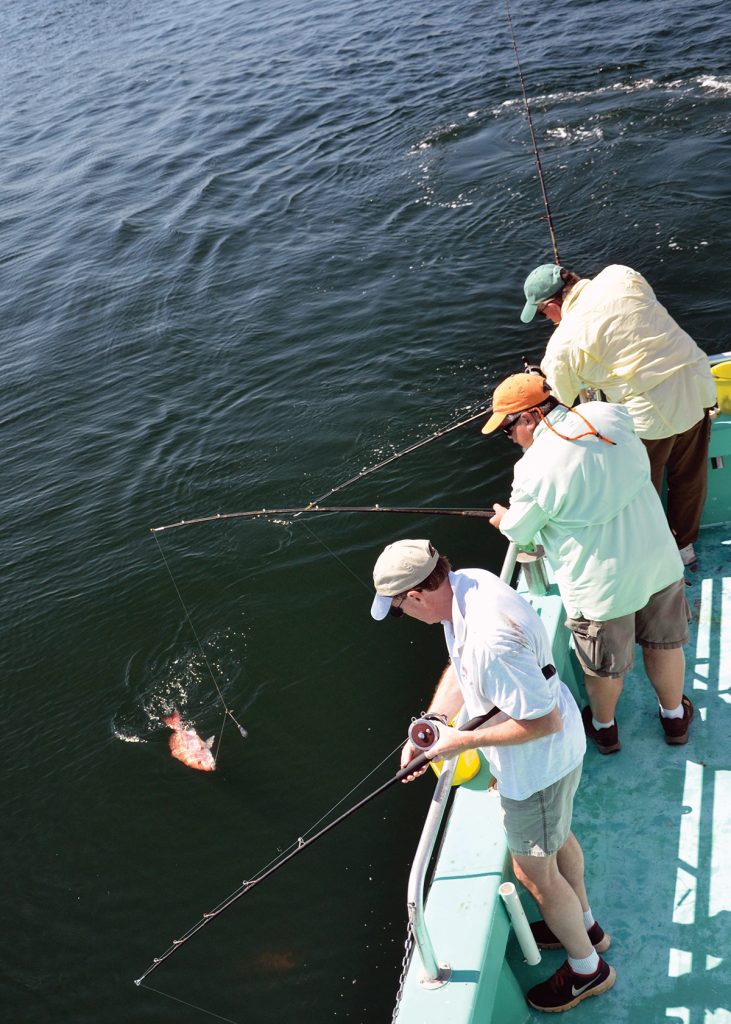Snapper season set to open for summer fun
The 2022 red snapper season will generally follow the same rules as last year. The season opens in state and federal waters on May 27. Recreational anglers will be able to keep snapper from 12:01 a.m. each Friday through 11:59 p.m. each Monday until the season closes.
“We don’t shoot for a target ending date because of too many factors involved in when the quota can be reached,” explains Scott Bannon, director of the Alabama Marine Resources Division on Dauphin Island. “People can fish for snapper each Friday through Monday until it looks like the quota will be met. I anticipate the season will probably stay open for 30 to 40 fishing days or about 10 weekends if the fishing effort is average and the weather stays favorable. If the weather turns bad, we encourage people to wait until the weather improves.”
For the past two years, the National Oceanic and Atmospheric Administration Fisheries allocated Alabama a quota of about 1.12 million pounds. Bannon says the poundage this year should be about the same. Last year, anglers fell slightly short of the quota.

“In 2021, Alabama recreational anglers landed about 952,000 pounds, but the season was open 124 days,” Bannon says. “Last year, we had some challenging weather early in the season so not as many people went offshore. As we progressed into the year, fishing efforts dropped with school openings, etc. We were open an extraordinary number of days and didn’t close the season until late December.”
Red snapper prefer deep water. When fish come up from the bottom too fast in deep water they could suffer “barotrauma.” Something similar occurs to divers returning to the surface too quickly. They can suffer “decompression sickness” or “the bends” when trapped gases in their bodies expand as pressure decreases.
For years, anglers would use venting tools, hollow needle-like devices to puncture the fish and let excess gases dissipate to alleviate that pressure before releasing the fish. New this year, the federal government requires that anglers use either a venting tool or a “descending device” when releasing deep-water fish.
“People will need to keep a descending device rigged and ready while fishing,” Bannon says. “To return a fish to the water, attach the fish to a descending device on a line and lower it back down. It has an adjustment where a person can set the depth. Release the fish back at the depth where it was caught. We want to make sure fish get back in their acclimated depth quickly to help with barotrauma.”
People must report all their red snapper, greater amberjack and gray triggerfish catches through the Snapper Check program. This helps fisheries managers keep track of the quotas and health of the resources. One person can report the entire catch for everyone on a vessel. Seasons, sizes and daily creel limits for various species differ so always check what’s legal before keeping any fish.
“Snapper Check is extremely important to us,” Bannon says. “Also, when the boat comes back to the dock, people might see an MRD staff person. Those people are conducting dockside surveys. Take a few minutes to answer their questions. It helps us develop a snapshot of what fishing looks like in Alabama. We also encourage people to use a free app called Fish Rules. It geolocates people and tell them what the limits and seasons are for that location.”
Skyrocketing fuel prices could discourage some people from heading offshore or limit the number of trips they make for snapper. Despite the smallest coastline on the Gulf of Mexico, Alabama established extensive artificial reef zones in offshore, nearshore and inshore waters to attract and hold fish. This makes Alabama one of the premier places in the nation to land red snapper and other reef fish. Fortunately, some artificial reefs sit close enough to shore that smaller boats can reach them without burning excessive fuel.
“We have arguably the world’s largest and best managed artificial reef zone,” Bannon says. “We have about 1,100 square miles of reef areas including multiple artificial reef zones relatively close to shore. We expanded the artificial reef zones by 110 square miles in 2021 by deploying 456 offshore reefs and some other inshore reefs. There’s an area south of Dauphin Island called the bridge rubble that’s very popular and relatively close to shore.”
For Snapper Check information and to keep up with landings, see outdooralabama.com/mrd-fisheries-section/red-snapper-faqs. For reef information and locations, see outdooralabama.com/saltwater-fishing/artificial-reefs.
John N. Felsher is a professional freelance writer who lives in Semmes, Ala. He also hosts an outdoors tips show for WAVH FM Talk 106.5 radio station in Mobile, Ala. Contact him at [email protected] or through Facebook.




